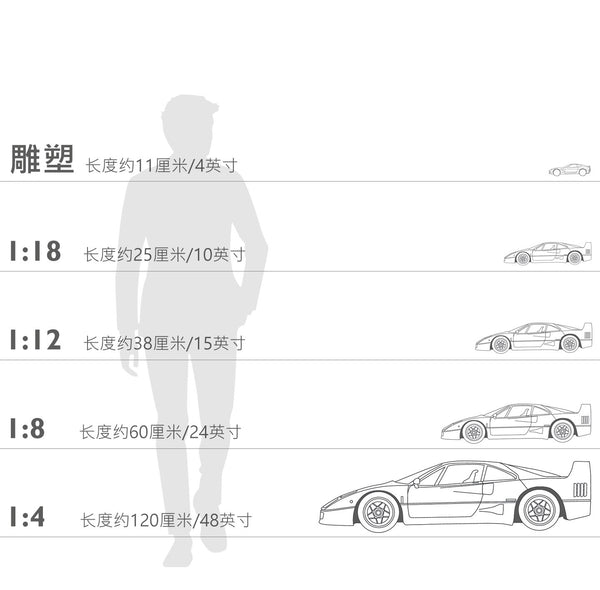技术详情
- 简介
- 比例指南
我们福特GT40系列的一个新版本,我们可以透露,我们正在开发一辆2号车的模型,这辆车在1966年由布鲁斯·迈凯伦和克里斯·阿蒙驾驶,在勒芒正式赢得比赛。我们的第一个原型预计在年中完成,首批限量版模型目前预计在第三季度推出。
福特GT40是有史以来最具标志性的赛车之一,它诞生于赛车运动中最臭名昭著的恩怨。在未能成功收购恩佐·法拉利备受赞誉的公司后,亨利·福特二世空手回到美国,并宣称他渴望在勒芒击败法拉利。结果就是诞生了一款能击败所有对手的赛车。
福特GT40在1964年至1969年间生产了五年,其开发在一开始特别随意。尽管福特拥有巨大的财富和生产能力,但作为一个组织,它在赛车方面的专业知识少之又少。福特与英国的洛拉汽车(Lola Cars)老板兼首席设计师埃里克·布罗德利(Eric Broadley)协商达成了一项协议,并派遣英国工程师罗伊·伦恩(Roy Lunn)回到英国,在该项目中担任关键角色,后者已经完成了初步设计。在美国设计师哈雷·科普(Harley Copp)的监督下,布罗德利、伦恩和前阿斯顿·马丁车队老板约翰·怀尔(John Wyer)组成的团队开始在布罗姆利的洛拉工厂研发这款新车。1963年底,该团队迁至斯劳,在新成立的福特高级车辆总部(Ford Advanced Vehicles HQ),由怀尔负责指导。1963年8月,迈凯伦汽车公司(McLaren Automotive)的布鲁斯·迈凯伦(Bruce McLaren)受雇对一款原型车进行评估,随后工作进展迅速,尽管在揭幕前才勉强完成。第一辆GT40,即GT/101(“GT40”这个名称后来才出现,取自该车的高度:挡风玻璃顶部高40英寸),于1964年4月1日在英国亮相,不久后在纽约展出。用于比赛的成品车购买价格为5200英镑(按现代价值计算超过10万英镑)。
由于福特汽车公司团队试图在10个月内完成法拉利历经数十年才完善的成果,这款车早期的问题显而易见。几周后的勒芒测试暴露出高速行驶时严重的不稳定问题;GT40能达到每小时200英里(321公里)的速度,但时速超过170英里(273公里)时就有飞离地面的趋势。在迈凯伦的建议下,车上加装了扰流板,并做了其他改进。此时,这款车已准备好参赛。然而,在纽伯格林、勒芒和兰斯等地的首次亮相堪称灾难,这些赛车很少能冲过终点线。勒芒赛事中的三辆车在比赛进行到12小时时都退赛了。作为回应,福特高层将该项目撤回美国,并将运营控制权交给了美国传奇前赛车手卡罗尔·谢尔比。谢尔比和他的研发车手肯·迈尔斯致力于改进设计,迈尔斯发现初始设计参数丢失,当他将悬架重置为原始设置后,性能大幅提升。空气动力学测试很快表明,气流状况比想象的更糟。谢尔比的美国工程师菲尔·雷明顿重新布置了管道以改变气流,使发动机又增加了79马力,同时更换为更轻质的材料:用玻璃纤维取代铝和钢,用更宽的镁合金轮毂取代钢丝辐条轮毂,还做了其他一些改进。突然间,GT40不仅看起来像一辆赛车,性能上也表现得像赛车了。
1966年,福特GT40的传奇故事拉开了帷幕。代托纳(赛车场)当时举办的已是一场24小时耐力赛,尽管法拉利没有派出任何一辆厂队赛车参赛,但肯·迈尔斯和劳埃德·鲁比在美国本土赛场带领车队以第一、第二、第三和第五名的成绩大获全胜。紧接着,在赛百灵(赛车场),由于唯一参赛的法拉利原型车在发生事故后退赛,福特车队再次以第一、第二、第三名的成绩赢得了比赛。然而,美国人梦寐以求的是勒芒(24小时耐力赛)的桂冠。那一年,福特为这场比赛集结了一支强大的队伍:八辆赛车、超过100名工作人员,以及三个私人车队共21吨的备用零件,他们的对手是11辆法拉利赛车,其中包括330P3和385P2型号。在这场艰苦的耐力赛中,福特以出色的表现击败了法拉利,包揽了领奖台的前三名,成为首个在勒芒夺冠的美国汽车制造商。在被法拉利拒绝合作三年后,福特研发出了世界上最优秀的耐力赛车之一,并在赛场上取得了胜利。凭借在勒芒的胜利,福特还荣获了国际制造商锦标赛的冠军。
与此同时,福特早在1967年就已开始研发一款全新的替代车型,该车型最初被称为J型车,后来被命名为Mk IV。Mk IV采用了更轻的铝蜂窝底盘,以及全新的车身设计,完美地将低风阻与高速稳定性结合在一起。在其首次参赛的赛百灵(24小时耐力赛)上,由布鲁斯·迈凯伦和马里奥·安德烈蒂驾驶的Mk IV立刻赢得了比赛。考虑到仅仅一个月前法拉利才在代托纳(赛车场)占据主导地位,这次胜利就显得更加引人注目。在勒芒(24小时耐力赛)上,丹·格尼和A.J.福伊特驾驶的赛车领先法拉利四圈冲过终点线,赢得了比赛。在这场竞争异常激烈的比赛中,最终只有15辆赛车完赛并获得了成绩,而他们也成为了首个也是唯一一个在勒芒夺冠的全美国阵容(美国底盘、发动机、轮胎、车队和车手)。一天后,针对1968年赛事的新规定宣布出台,Mk IV因此被淘汰,新规将原型车组别的发动机排量限制在三升以内。然而,对于福特GT40来说,这还不是它的终点。
为了吸引更多能角逐全场总冠军的参赛车辆,像福特GT40这样的现有跑车也被允许参赛,条件是如果至少生产了50辆车,发动机最大排量可为5升。约翰·怀尔的车队对一些Mk I型车进行了改装,将4.7升的发动机增大到4.9升,并采取措施在缸体和缸盖之间安装O型密封圈,以防止气缸垫故障,这是4.7升发动机常见的问题。底盘编号为#1075的赛车,身披海湾石油国际公司标志性的蓝橙相间涂装,在佩德罗·罗德里格斯和吕西安·比安奇的驾驶下,在勒芒(24小时耐力赛)中获胜,击败了保时捷、阿尔法·罗密欧等品牌脆弱的小排量3升原型车。这场比赛由于法国当年早些时候的动荡而被推迟到9月举行,是该赛季的最后一场比赛。结果,福特出人意料地从保时捷手中夺走了1968年国际汽车制造商锦标赛的冠军头衔。编号#1075的赛车在1969年的勒芒赛事中再次登场,它面临着经验更丰富的原型车,以及搭载新型但仍不稳定的4.5升水平对置12缸发动机的保时捷917。杰克·埃克斯和杰基·奥利弗付出了非凡的努力,在跑了372圈后,他们仅以120米(390英尺)的优势战胜了汉斯·赫尔曼和热拉尔·拉鲁斯驾驶的保时捷908,赢得了比赛。这创造了勒芒24小时耐力赛历史上最接近的完赛差距,也是整个赛车运动历史上最伟大的比赛之一。福特GT40或许在当时已经过时了,但它在过去四年里对勒芒赛场的统治,无疑奠定了它在赛车运动史册中作为最成功赛车之一的地位。
这款完美的1:8比例福特GT40模型是基于底盘编号为#1046的实车打造的。1966年6月18日和19日,在萨尔特赛道举行的勒芒24小时耐力赛中,布鲁斯·迈凯伦和克里斯·阿蒙驾驶着底盘编号为#1046的赛车赢得了比赛胜利。在八辆参赛的福特GT40 Mark II赛车中,#1046赛车在排位赛中获得第四名,排在丹·格尼和杰里·格兰特、肯·迈尔斯和丹尼·休姆、约翰·惠特莫尔和弗兰克·加德纳驾驶的其他几辆Mark II赛车之后,但领先于速度最快的法拉利赛车——一辆由佩德罗·罗德里格斯和里奇·金瑟驾驶的330 P3 Spyder。
亨利·福特二世担任了荣誉发令员,他挥舞旗帜宣布比赛开始。比赛一开始,迈尔斯在关车门时夹住了头盔,因此不得不进站进行修理;而迈凯伦仅仅跑了三圈后,就因为需要更换轮胎而进站。其余的赛车则继续轰鸣着向前飞驰,在比赛的前半段,福特和法拉利的赛车多次交替领先。到晚上8点时,只有三辆赛车处于领先圈数,迈尔斯驾驶的赛车领先于福特车队的格尼和法拉利车队的罗德里格斯,而迈凯伦/阿蒙驾驶的赛车则落后一圈。黄昏时分,细雨浸湿了赛道,这削弱了大型GT40赛车的动力优势,而几辆福特赛车选择提前更换刹车片,这让法拉利赛车得以保持与领先集团的距离。午夜过后,形势开始逆转:法拉利的赛车开始因机械故障退赛,尽管福特车队也有一些赛车退出比赛,但美国车队的大部分赛车仍在继续比赛,一度在前八名中占据了七个席位,这些赛车包括GT40 Mark II和Mark I型号。到凌晨4点时,最后一辆法拉利赛车也退出了比赛,车队接到指令开始放慢速度,从最初每圈3分30秒的速度调整为更具策略性的每圈3分50秒,以确保大多数赛车能够完成比赛。
格尼在当晚的大部分时间里都处于领先位置,迈尔斯和迈凯伦则根据他们进站的顺序交替占据第二和第三名,直到上午中段,3号福特赛车的气缸盖衬垫损坏,被迫退赛。尽管遭遇了这一挫折,福特车队仍然凭借谢尔比美国车队的迈尔斯/休姆、迈凯伦/阿蒙以及霍尔曼&穆迪车队的巴克纳姆和赫奇森占据了前三名。比赛还剩两小时的时候,福特赛车运动总监利奥·比伯与卡罗尔·谢尔比会面,商讨车队应如何应对比赛的收尾阶段。领先的车手们设法让迈尔斯和迈凯伦之间形成了一种僵持局面,他们告诉两位车手都要放慢速度,尤其是当时处于领先位置的迈尔斯,以便让赫奇森追上他们,确保在比赛结束时福特车队能包揽领奖台的三个位置。在最后一圈,三辆福特赛车并排行驶,迈尔斯和迈凯伦几乎同时冲过终点线,赫奇森紧随其后。冲线照片完整地记录了这一幕。然而,有争议的是,根据法国汽车俱乐部(ACO)的规则,由于迈凯伦和阿蒙的发车位置更靠后,他们在比赛中行驶的距离更远,因此2号赛车被宣布为获胜者。就这样,福特成为了首个在勒芒夺冠的美国汽车制造商,布鲁斯·迈凯伦和克里斯·阿蒙也成为了第一批取得这一壮举的新西兰人。在勒芒的胜利也让福特在国际制造商锦标赛中以微弱优势战胜了法拉利。
1966年勒芒夺冠的福特GT40(车型)仅限量生产199辆。
预定
定制
为了让我们创建您的定制模型,您需要选择4个其他选项。 油漆颜色,内饰颜色,车轮样式和卡钳颜色。
请填写表格,我们的销售团队成员将与您联系。
联系我们
请与我们联系以获取有关订购此型号的更多信息。





